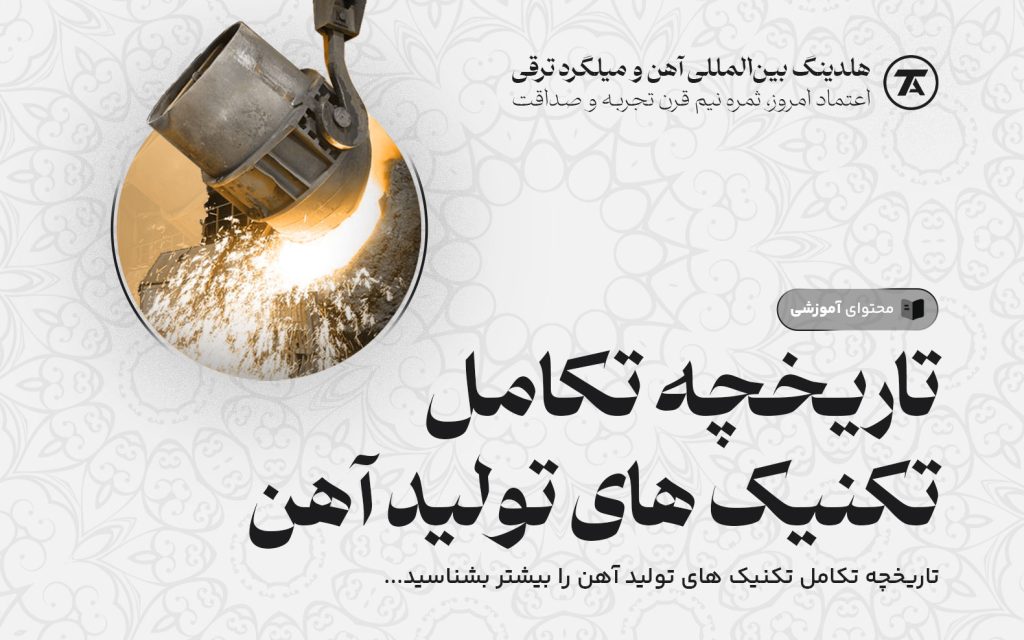History of evolution of iron production techniques

Iron is one of the most important metals in the world. For thousands of years, iron has been used in various applications, from weapons and tools to construction materials and machinery. The methods of iron production have evolved over time and new techniques and technologies have been created that have led to the development of iron production in terms of efficiency, quality and quantity. In the following, we will examine the history of iron production methods as well as the evolution of production techniques of this widely used and popular metal for humans. In this way, our short journey from ancient times to today will continue. So fasten your seat belt!
The first evidence of iron production dates back to around 1200 BC in Anatolia (modern day Turkey) and the Caucasus region. At that time and place, to make iron, iron ore was heated by charcoal in a furnace. This process of making and producing iron is known as smelting. In this method, pieces of iron were made. Next, these pieces were made into hammers. The quality of iron produced in this way was low and impurities such as carbon and slag remained in the metal.
In ancient Greece, iron production was improved by using tails to increase the air flow to the furnace, and as a result, the temperature of the furnaces increased and iron was produced with better quality. As air was blown into the furnace, the fire of the furnace would burn much more. This caused the furnace temperature to rise much higher. The Greeks also expanded the production of tools and weapons from iron by inventing new methods.
During the Middle Ages, iron production was common in Europe by heating in furnaces and hammering. In this method, iron ore was heated in a furnace heated by charcoal. In the next step, the iron was hit with a hammer to remove impurities from the iron. The process was slow and inefficient, producing small amounts of low-quality iron. However, because the materials needed to make iron in this way were abundant and available, making iron with this technique was able to gain a lot of popularity among the people of Europe in the Middle Ages.
In the 14th century, a new process called the blast furnace was developed in Europe for making iron and related tools. This method involved blowing air into the furnace to raise the temperature and produce liquid iron. The blast furnace made it possible to produce high-quality iron on a large scale. The iron produced by this method was mostly used to make weapons, tools and machines.
The industrial revolution in the 18th and 19th centuries led us to see more advances in the production and manufacturing techniques of iron. The invention, construction and development of steam engines made it possible to use the blast furnace more efficiently. On the other hand, new methods were developed for iron purification. One of these methods was the Bessemer process. In this process, air is blown into the molten iron with great intensity and power. This work removes impurities from iron and makes iron and steel of much higher quality to be produced.
In the 20th century, iron production continued to evolve with the development of electric arc furnaces and other advanced technologies. Of course, the electric arc furnace entered the field of iron making in the early nineteenth century; The end of the popularity of these furnaces was in the 20th century. These methods and techniques caused more efficiency and quality in iron production and steel became the dominant form of iron used in the industry.
Today, iron production is an automated and highly efficient process. Raw materials such as iron ore and coke are brought into blast furnaces where they are heated to very high temperatures to produce liquid iron and steel. This molten iron is then refined and transformed into various forms of steel for use in construction, machinery and other applications.
In conclusion, it can be said that the history of the evolution of iron production techniques is a fascinating story of human ingenuity and innovation. From the simple process of heat and impact, in ancient times, to the highly advanced, automated blast furnaces of today, each technique is based on the knowledge and experience of a human or a group of humans who have come and lived before. Apart from all these things that we reviewed together; Iron will continue to be an essential metal in our modern world, and the evolution of its production techniques will undoubtedly continue.

















